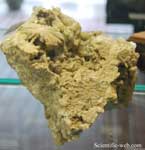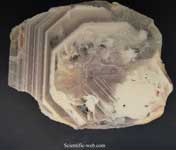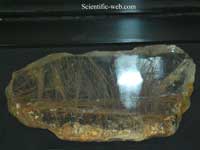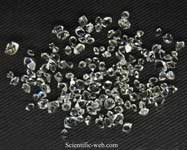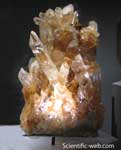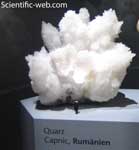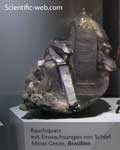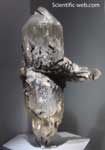| - Art Gallery - |
Star Quartz, Quartz, Rutilated Quartz,
Smoky Quartz , Quartz with Tourmaline Quartz is the second most abundant mineral in the Earth's continental crust, after feldspar. It is made up of a continuous framework of SiO4 silicon–oxygen tetrahedra, with each oxygen being shared between two tetrahedra, giving an overall formula SiO2. There are many different varieties of quartz, several of which are semi-precious gemstones. Especially in Europe and the Middle East, varieties of quartz have been since antiquity the most commonly used minerals in the making of jewelry and hardstone carvings. The word "quartz" is derived from the German word "quarz", which was imported from Middle High German, "twarc", which originated in Slavic (cf. Czech tvrdy ("hard"), Polish twardy ("hard"), Russian твёрдый ("hard")), from Old Church Slavonic тврьдъ ("firm"), from Proto-Slavic *tvьrdъ.[6] Crystal habit At surface temperatures and pressures, quartz is the most stable form of silicon dioxide. Quartz will remain stable up to 573 °C at 1 kilobar of pressure. As the pressure increases the temperature at which quartz will lose stability also increases. Above 1300 °C and at a pressure of approximately 35 kilobars, only β-quartz is stable. The latter is not the same as normal quartz (or α-quartz), low quartz or just quartz. β-quartz has higher symmetry, is less dense and has a slightly lower specific gravity. The conversion, from one solid substance to another solid substance, of quartz to β-quartz is quick, reversible and accompanied with a slight energy absorption. The conversion is so easily accomplished that when a crystal of quartz is heated to β-quartz, cooled back down, heated again to β-quartz, etc., then when all is done the quartz will be the same as when it started. The reason that the conversion is so easily accomplished is that the difference between quartz and β-quartz is relatively slight. The bonds between the oxygen and silicon atoms are "kinked" or bent in quartz and are not so "kinked" in β-quartz. At the higher temperatures the atoms move away from each other just enough to allow the bonds to unkink or straighten and produce the higher symmetry. As the temperature is lowered, the atoms close in on each other and the bonds must kink in order to be stable and this lowers the symmetry back down again. Although all quartz at temperatures lower than 573 °C is low quartz, there are a few examples of crystals that obviously started out as β-quartz. Sometimes these are labeled as β-quartz but are actually examples of pseudomorphic or "falsely shaped" crystals more correctly labeled 'quartz after β-quartz'. These crystals are of higher symmetry than low quartz although low quartz can form similar crystals to them. They are composed of hexagonal dipyramids which are a pair of opposing six sided pyramids and the crystals lack prism faces. Quartz's typical termination is composed of two sets of three rhombic faces that can look like a six sided pyramid. (Microscopic) crystal structure α-quartz crystallizes in the trigonal crystal system, space group P3121 and P3221 respectively. β-quartz belongs to the hexagonal system, space group P6221 and P6421, respectively.[7] These spacegroups are truly chiral (they each belong to the 11 enantiomorphous pairs). Both α-quartz and β-quartz are examples of chiral crystal structures composed of achiral building blocks (SiO4 tetrahedra in the present case). The transformation between α- and β-quartz only involves a comparatively minor rotation of the tetrahedra with respect to one another, without change in the way they are linked. Varieties (according to color) Citrine Smokey quartz Citrine is a variety of quartz whose color ranges from a pale yellow to brown. It is nearly impossible to tell cut citrine from yellow topaz visibly. Citrine has ferric impurities, and is rarely found naturally. Most commercial citrine is in fact artificially heated amethyst or smoky quartz. Brazil is the leading producer of citrine, with much of its production coming from the state of Rio Grande do Sul. The name is derived from Latin citrina which means "yellow" and is also the origin of the word "citron."[9] Citrine is one of three traditional birthstones for the month of November. Rose quartz Rose quartz is a type of quartz which exhibits a pale pink to rose red hue. The color is usually considered as due to trace amounts of titanium, iron, or manganese, in the massive material. Some rose quartz contains microscopic rutile needles which produces an asterism in transmitted light. Recent X-ray diffraction studies suggest that the color is due to thin microscopic fibers of possibly dumortierite within the massive quartz.[10] In crystal form (rarely found) it is called pink quartz and its color is thought to be caused by trace amounts of phosphate or aluminium. The color in crystals is apparently photosensitive and subject to fading. The first crystals were found in a pegmatite found near Rumford, Maine, USA, but most crystals on the market come from Minas Gerais, Brazil.[11] Rose quartz is not popular as a gem – it is generally too clouded by impurities to be suitable for that purpose. Rose quartz is more often carved into figures such as people or hearts. Hearts are commonly found because rose quartz is pink and an affordable mineral. Amethyst Main article: Amethyst Amethyst is a popular form of quartz that ranges from a bright to dark or dull purple color. Smoky quartz Smoky quartz is a gray, translucent version of quartz. It ranges in clarity from almost complete transparency to a brownish-gray crystal that is almost opaque. Some can also be black. Milky quartz Milk quartz or milky quartz may be the most common variety of crystalline quartz and can be found almost anywhere. The white color may be caused by minute fluid inclusions of gas, liquid, or both, trapped during the crystal formation. The cloudiness caused by the inclusions effectively bars its use in most optical and quality gemstone applications.[12] Varieties (according to microstructure) Although many of the varietal names historically arose from the color of the mineral, current scientific naming schemes refer primarily to the microstructure of the mineral. Color is a secondary identifier for the cryptocrystalline minerals, although it is a primary identifier for the macrocrystalline varieties. This does not always hold true.
Synthetic and artificial treatments
Due to natural quartz being so often twinned, much of the quartz used in industry is synthesized. Large, flawless and untwinned crystals are produced in an autoclave via the hydrothermal process; emeralds are also synthesized in this fashion. While these are still commonly referred to as quartz, the correct term for this material is silicon dioxide. Occurrence Quartz is an essential constituent of granite and other felsic igneous rocks. It is very common in sedimentary rocks such as sandstone and shale and is also present in variable amounts as an accessory mineral in most carbonate rocks. It is also a common constituent of schist, gneiss, quartzite and other metamorphic rocks. Because of its resistance to weathering it is very common in stream sediments and in residual soils. Quartz occurs in hydrothermal veins as gangue along with ore minerals. Large crystals of quartz are found in pegmatites. Well-formed crystals may reach several meters in length and weigh hundreds of kilograms. Naturally occurring quartz crystals of extremely high purity, necessary for the crucibles and other equipment used for growing silicon wafers in the semiconductor industry, are expensive and rare. A major mining location for high purity quartz is the Spruce Pine Gem Mine in Spruce Pine, North Carolina.[13] Related silica minerals Tridymite and cristobalite are high-temperature polymorphs of SiO2 that occur in high-silica volcanic rocks. Coesite is a denser polymorph of quartz found in some meteorite impact sites and in metamorphic rocks formed at pressures greater than those typical of the Earth's crust. Stishovite is a yet denser and higher-pressure polymorph of quartz found in some meteorite impact sites. Lechatelierite is an amorphous silica glass SiO2 which is formed by lightning strikes in quartz sand. History
Quartz is the most common material identified as the mystical substance maban in Australian Aboriginal mythology. It is found regularly in passage tomb cemeteries in Europe in a burial context, such as Newgrange or Carrowmore in the Republic of Ireland. The Irish word for quartz is grian cloch, which means 'stone of the sun'. While jade has been since earliest times the most prized semi-precious stone for carving in East Asia and Pre-Columbian America, in Europe and the Middle East the different varieties of quartz were the most commonly used for the various types of jewelry and hardstone carving, including engraved gems and cameo gems, rock crystal vases, and extravagant vessels. The tradition continued to produce objects that were very highly valued until the mid-19th century, when it largely fell from fashion except in jewelry. Cameo technique exploits the bands of color in onyx and other varieties. Roman naturalist Pliny the Elder believed quartz to be water ice, permanently frozen after great lengths of time. (The word "crystal" comes from the Greek word for purity.) He supported this idea by saying that quartz is found near glaciers in the Alps, but not on volcanic mountains, and that large quartz crystals were fashioned into spheres to cool the hands. He also knew of the ability of quartz to split light into a spectrum. This idea persisted until at least the 1600s. In the 17th century, Nicolas Steno's study of quartz paved the way for modern crystallography. He discovered that no matter how distorted a quartz crystal, the long prism faces always made a perfect 60° angle. Charles B. Sawyer invented the commercial quartz crystal manufacturing process in Cleveland, Ohio, United States. This initiated the transition from mined and cut quartz for electrical appliances to manufactured quartz. Quartz's piezoelectric properties were discovered by Jacques and Pierre Curie in 1880. The quartz oscillator or resonator was first developed by Walter Guyton Cady in 1921.[16] George Washington Pierce designed and patented quartz crystal oscillators in 1923.[17] Warren Marrison created the first quartz oscillator clock based on the work of Cady and Pierce in 1927.[18] Piezoelectricity Quartz crystals have piezoelectric properties; they develop an electric potential upon the application of mechanical stress. An early use of this property of quartz crystals was in phonograph pickups. One of the most common piezoelectric uses of quartz today is as a crystal oscillator. The quartz clock is a familiar device using the mineral. The resonant frequency of a quartz crystal oscillator is changed by mechanically loading it, and this principle is used for very accurate measurements of very small mass changes in the quartz crystal microbalance and in thin-film thickness monitors.
1. ^ a b c Deer, W. A., R. A. Howie and J. Zussman, An Introduction to the Rock Forming Minerals, Logman, 1966, pp. 340–355 ISBN 0-582-44210-9 Retrieved from "http://en.wikipedia.org/" |
|
